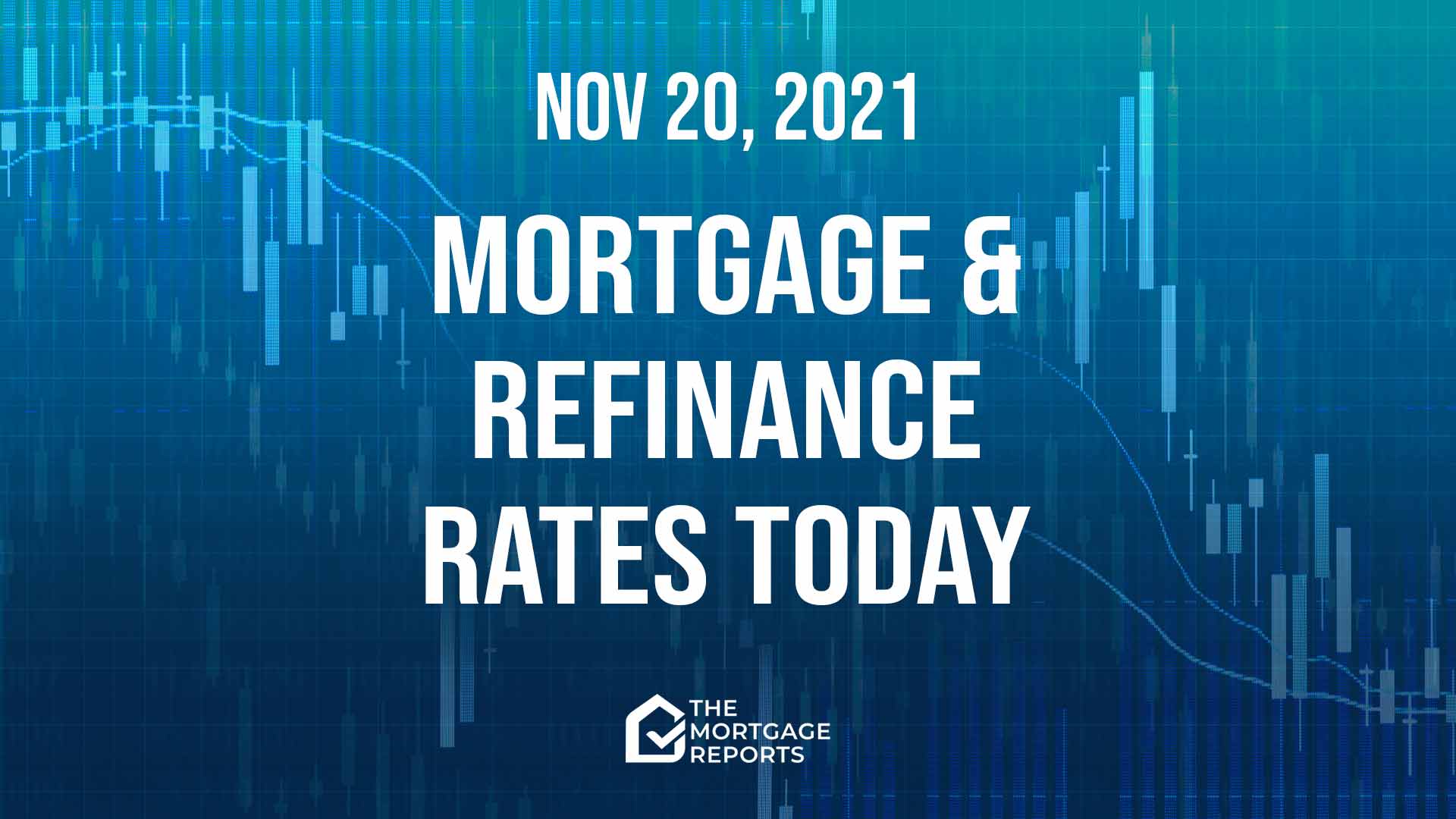
Today’s mortgage and refinance rates
Average mortgage rates fell again yesterday, but this time by a worthwhile amount. And they’re now roughly midway between their highest and lowest levels in the last 30 days.
I’m changing my weekly prediction! Because I think mortgage rates might fall further next week. Read on for my reasons.
Find and lock a low rate (Nov 20th, 2021)Current mortgage and refinance rates
| Program | Mortgage Rate | APR* | Change |
|---|---|---|---|
| Conventional 30 year fixed | |||
| Conventional 30 year fixed | 3.261% | 3.279% | Unchanged |
| Conventional 15 year fixed | |||
| Conventional 15 year fixed | 2.671% | 2.701% | -0.02% |
| Conventional 20 year fixed | |||
| Conventional 20 year fixed | 3.108% | 3.143% | -0.01% |
| Conventional 10 year fixed | |||
| Conventional 10 year fixed | 2.66% | 2.718% | -0.01% |
| 30 year fixed FHA | |||
| 30 year fixed FHA | 3.294% | 4.058% | -0.06% |
| 15 year fixed FHA | |||
| 15 year fixed FHA | 2.614% | 3.259% | -0.01% |
| 5/1 ARM FHA | |||
| 5/1 ARM FHA | 2.383% | 3.118% | -0.06% |
| 30 year fixed VA | |||
| 30 year fixed VA | 2.869% | 3.055% | -0.02% |
| 15 year fixed VA | |||
| 15 year fixed VA | 2.745% | 3.087% | +0.01% |
| 5/1 ARM VA | |||
| 5/1 ARM VA | 2.501% | 2.367% | -0.02% |
| Rates are provided by our partner network, and may not reflect the market. Your rate might be different. Click here for a personalized rate quote. See our rate assumptions here. | |||
Should you lock a mortgage rate today?
I still think mortgage rates will rise in the long term. But they may catch a break over the winter, depending on the extent to which there’s a resurgence in COVID-19.
I’d like a while longer to study emerging pandemic data before I change my personal rate lock recommendations. But, if you’re convinced that COVID-19 will wreak economic havoc over the coming months, you might ignore those.
Still, for now, those recommendations remain:
- LOCK if closing in 7 days
- LOCK if closing in 15 days
- LOCK if closing in 30 days
- LOCK if closing in 45 days
- LOCK if closing in 60 days
However, with so much uncertainty at the moment, your instincts could easily turn out to be as good as mine — or better. So be guided by your gut and your personal tolerance for risk.
What’s moving current mortgage rates
According to CNBC, yesterday’s worthwhile fall in mortgage rates was mostly down to speculation over the chairmanship of the Federal Reserve. Will incumbent Jerome Powell stay on or will the president appoint someone else?
Among the front-runners, if a replacement is required, is Lael Brainard, who’s served on the Fed’s board of governors for the last seven years. She’s known to be a “dove.” And her appointment might see mortgage rates rise more slowly than if Powell stays on.
Meanwhile, other senior Fed people have been suggesting that the organization should withdraw its support for artificially low mortgage rates more quickly. Regular readers will know that I’m talking about “tapering” here.
Yesterday, Federal Reserve vice chairman Richard Clarida and Fed governor Christopher Waller both advocated accelerating cuts to the program. And, if they get their way, we might see mortgage rates rise sooner than otherwise.
So things are up in the air as far as the Fed’s concerned. And we’ll just have to wait to see how they land before even trying to work out their implications for mortgage rates.
The pandemic
Is COVID-19 beginning to raise its ugly head again? It certainly is in Europe, where Austria has just imposed a 10-day lockdown. And Germany is introducing new, stricter measures.
But things look grim globally. Our World in Data reckons there were 745,000 daily new cases worldwide on Aug. 27, falling to 313,000 on Oct. 17. But the numbers have climbed since then. And, on Nov. 18, they stood at 613,000. If the numbers maintain that trajectory, we could be in for a bad winter, both medically and economically.
And the same is happening here at home. There were 285,000 new cases in the US on Sept. 13, falling to 71,000 on Oct. 26. Yesterday, it was back up to 119,000, according to The New York Times (paywall). Again, that’s a worrying trajectory, especially as winter is yet to do its worst.
I often quote the forces that are acting to push mortgage rates higher. But they all have their roots in the pandemic. And a resurgence in that could see them all melt away.
So inflation could fall, the Fed might reverse its tapering policy and the economic recovery could be throttled. And all of those should bring lower mortgage rates, though little other cheer.
However, it’s unlikely the economic harm a pandemic resurgence could bring will survive the spring. And it may be less of a problem than doomsayers predict. Although US vaccination rates are low by comparison with the rest of the developed world, 59% of the population has been fully vaccinated. And millions of Americans may have some protection from previous infections.
Of course, that will have only a limited effect on COVID-19 infection rates. But it might significantly reduce hospitalizations, deaths and economic damage. And that might see mortgage rates fall less far, if at all.
Better news in 2022
All that’s pretty depressing. So here’s some better news from The Economist:
PANDEMICS DO NOT die — they fade away. And that is what COVID-19 is likely to do in 2022. True, there will be local and seasonal flare-ups, especially in chronically undervaccinated countries. Epidemiologists will also need to watch out for new variants that might be capable of outflanking the immunity provided by vaccines. Even so, over the coming years, as covid settles into its fate as an endemic disease, like flu or the common cold, life in most of the world is likely to return to normal — at least, the post-pandemic normal.
— The Economist, “COVID-19 is likely to fade away in 2022,” Nov. 8, 2021
Economic reports next week
Happy Thanksgiving! The holiday means all next week’s economic reports are crammed into the first three days. And Wednesday’s a humdinger, with some genuinely important reports. See them listed below, with the key ones emboldened.
The Federal Reserve will also release on Wednesday the minutes of the last meeting of its Federal Open Market Committee. That’s the Fed’s monetary policy body and investors and analysts always pore over these minutes.
However, heaven knows how much attention anyone will pay to the landslide of data and reports that day. Many will be thinking mainly of the next day’s holiday.
None of the other economic reports listed below is likely to cause much movement in markets unless it includes shockingly good or bad data:
- Monday — October existing home sales
- Wednesday — Q3 GDP revision; core inflation; orders for durable and core capital goods; personal income, real disposable income and consumer spending; new home sales. And final reading of the consumer sentiment index for November. Plus weekly new claims for unemployment insurance to Nov. 20. All in the list relate to October, unless otherwise stated
Wednesday’s huge. If anyone pays attention.
Find and lock a low rate (Nov 20th, 2021)
Mortgage interest rates forecast for next week
Mortgage rates might fall next week. Of course, the opposite might happen.
But markets do seem to be developing worries about the pandemic and the chairmanship of the Fed. So a fall may be the more likely scenario.
In the longer term, I’m still expecting higher mortgage rates. But how soon they come and how high they climb will depend on how bad this winter turns out to be for the economy.
Mortgage and refinance rates usually move in tandem. And a gap that had grown between the two has been largely eliminated by the recent scrapping of the adverse market refinance fee.
And another recent regulatory change has likely made mortgages for investment properties and vacation homes more accessible and less costly.
How your mortgage interest rate is determined
Mortgage and refinance rates are generally determined by prices in a secondary market (similar to the stock or bond markets) where mortgage-backed securities are traded.
And that’s highly dependent on the economy. So mortgage rates tend to be high when things are going well and low when the economy’s in trouble.
Your part
But you play a big part in determining your own mortgage rate in five ways. And you can affect it significantly by:
- Shopping around for your best mortgage rate — They vary widely from lender to lender
- Boosting your credit score — Even a small bump can make a big difference to your rate and payments
- Saving the biggest down payment you can — Lenders like you to have real skin in this game
- Keeping your other borrowing modest — The lower your other monthly commitments, the bigger the mortgage you can afford
- Choosing your mortgage carefully — Are you better off with a conventional, FHA, VA, USDA, jumbo or another loan?
Time spent getting these ducks in a row can see you winning lower rates.
Remember, it’s not just a mortgage rate
Be sure to count all your forthcoming homeownership costs when you’re working out how big a mortgage you can afford. So focus on your “PITI.” That’s your Principal (pays down the amount you borrowed), Interest (the price of borrowing), (property) Taxes, and (homeowners) Insurance. Our mortgage calculator can help with these.
Depending on your type of mortgage and the size of your down payment, you may have to pay mortgage insurance, too. And that can easily run into three figures every month.
But there are other potential costs. So you’ll have to pay homeowners association dues if you choose to live somewhere with an HOA. And, wherever you live, you should expect repairs and maintenance costs. There’s no landlord to call when things go wrong!
Finally, you’ll find it hard to forget closing costs. You can see those reflected in the annual percentage rate (APR) you’ll be quoted. Because that effectively spreads them out over your loan’s term, making that higher than your straight mortgage rate.
But you may be able to get help with those closing costs your down payment, especially if you’re a first-time buyer. Read:
Down payment assistance programs in every state for 2021



